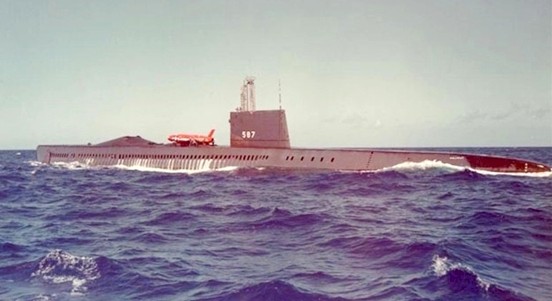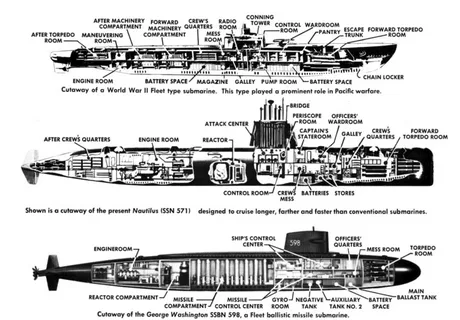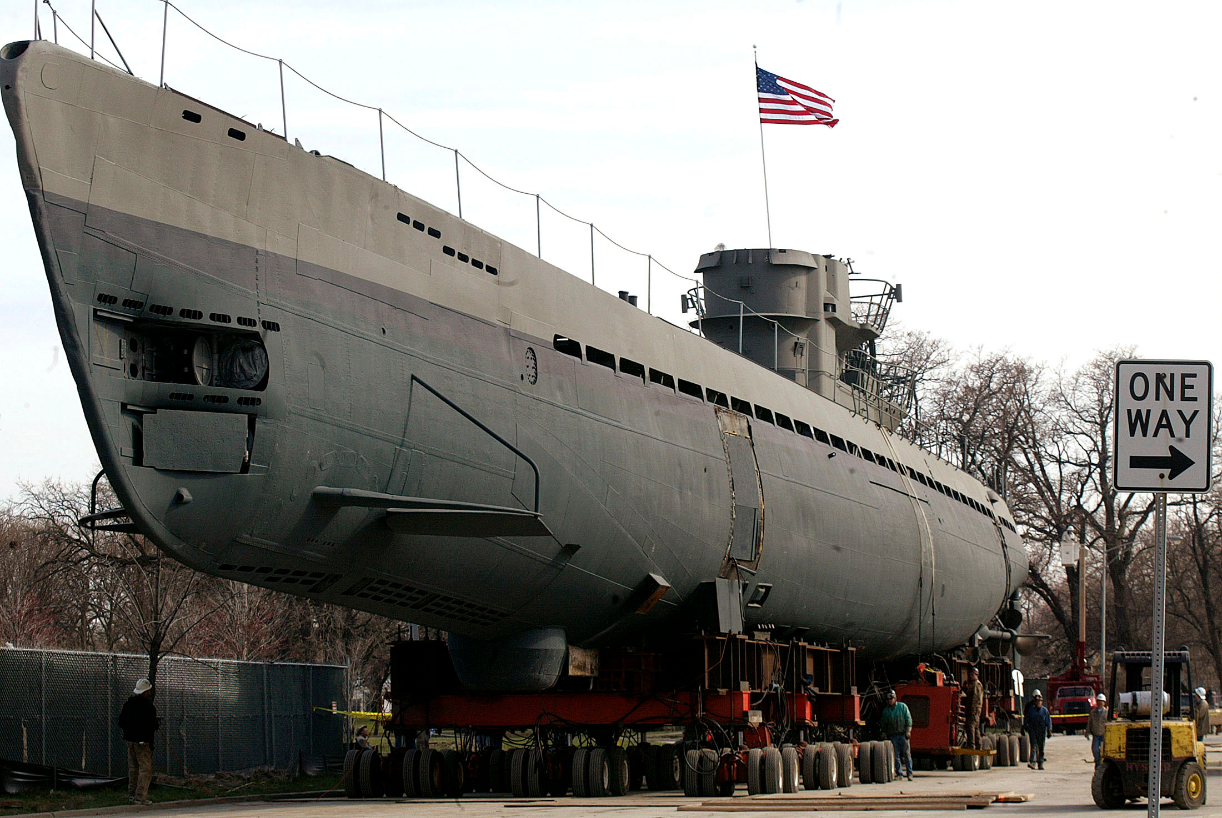“…So many more, subs by the score, went to their watery grave,
In silence deep, they lie asleep, the young lads and the brave,
But this I know, somewhere below lie those who paid the price,
Our debt is paid because they made the final sacrifice.”
By: Robert L. Harrison
A submarine carrying the name USS Halibut has seen service under three designations. USS Halibut I (a Gato-class boat (SS-232) from 1942-45) was the first vessel of the United States Navy to be named for the halibut, a large, up to 500-pound species of flatfish typically found at the bottom of relatively shallow waters in the Pacific and Atlantic oceans. Of the original WWII Halibut, Commander Graham C. Scarbro (USN) poignantly wrote, “The Gato-class submarine USS Halibut (SS-232) slid through the waters of the Luzon Strait, prowling for Japanese surface vessels.” As the sun rose over her stern on 14 November 1944, her skipper, Lieutenant Commander Ignatius J. “Pete” Galantin, ordered the boat to dive. Increased aerial traffic observed during the night was a promising sign that the Halibut was in the right place. Galantin had a hunch that Japanese shipping, bound to reinforce or resupply beleaguered enemy troops in the Philippines, would soon pass through the Bashi Channel at the north end of the strait.

Operating alongside the USS Haddock (SS-231) and Tuna (SS-203), she had sunk the Japanese destroyer Akizuki during the Battle of Leyte Gulf three weeks before. Now the crew, a mix of plank owners, veterans, and new recruits, was ready for more. They did not know this would be the Halibut’s final cruise… with the war in the Pacific winding down, the Navy determined damage to Halibut in the Luzon strait [‘The crew toiled with repairs, and when night came she resurfaced… The radar was repaired, although Halibut was without depth gauges, main compasses, gyros, radio, and a number of other systems. Most of the damage was actually to the hull and its fittings.’] It was too extensive to justify repairing the boat, and she was scheduled for decommissioning. Plans to convert her to a school ship did not materialize, and she was sold for scrap for $23,123. Over her ten war patrols, the Halibut won seven battle stars and sank 12 enemy ships totaling 45,257 tons; she damaged 13 more enemy vessels.” Her skipper earned the Navy Cross and Silver Star.
USS Halibut II: The Nuclear-Powered Pioneer
From 1960-76, there was the USS Halibut II (SSGN-587), built at Mare Island and commissioned on 4 Jan. It was converted to an Attack Submarine at Pearl Harbor Naval Shipyard from 6 Feb 1965 to 6 Sep 1965 and redesignated (SSN-587) on 8 Aug 1965. It displaced 3.655 tons (5,000 tons submerged) at a length of 350 feet with a beam of 29 feet. The vessel’s complement was 9-10 officers and 88 enlisted. Its armament consisted of one Regulus I missile launcher, and Halibut could carry five in the hangar. In addition, it had six 21″ torpedo tubes (4 forward & 2 aft). It was powered by the S3G nuclear reactor with twin 5-bladed propellers and had been awarded two Presidential Unit Citations, two (or possibly three) Navy Unit Commendations, the Navy E ribbon, and the National Defense Service Medal.

The nuclear USS Halibut was the first submarine in the world, designed and built from the keel up, to launch guided missiles. She was also the first submarine to carry the Ships Inertial Navigation System (SINS). In September 1959, with the 1st patrol of Grayback, an era of submarine history began that would go unrecognized for almost 40 years. Five Regulus submarines: USS Grayback (SSG 574), USS Tunny (SSG 282), USS Barbero (SSG 317), USS Growler (SSG 577) and USS Halibut (SSGN 587) deployed on 41 deterrent patrols under the earth’s oceans over the course of 5 years. These deterrent patrols represented the first ever in the history of the submarine Navy and preceded those made by the Polaris missile firing submarines. Navy TWS lists 57 registered members who served aboard this vessel.
USS Halibut in Cold War Espionage and Covert Operations
The SSM-N-8A Regulus weapon borne by the last USS Halibut was a US Navy-developed ship-and-submarine-launched, nuclear-capable, turbojet-powered second-generation cruise missile, deployed from 1955 to 1964. Its development was an outgrowth of tests conducted with the German V-1 missile at NAS Point Mugu in California. Its barrel-shaped fuselage resembled that of numerous fighter aircraft designs of the post-WWII era, but without a cockpit. When the missiles were deployed, they were launched from a rail launcher and equipped with a pair of Aerojet JATO bottles on the aft end of the fuselage. Halibut, with its extremely large internal hangar, could carry five missiles and was intended to be the prototype of a whole new class of cruise missile-firing SSG-N submarines. Despite being the U.S. Navy’s first underwater nuclear capability, the Regulus missile system had significant operational drawbacks. In order to launch, the submarine had to surface and assemble the missile in whatever sea conditions it was in. “Because it required active radar guidance, which only had a range of 225 nmi (259 mi; 417 km), the ship had to stay stationary on the surface to guide it to the target while effectively broadcasting its location. This guidance method was susceptible to jamming, and since the missile was subsonic, the launch platform remained exposed and vulnerable to attack during its flight duration; destroying the ship would effectively disable the missile in flight.” A second-generation supersonic Vought SSM-N-9 Regulus II cruise missile with a range of 1,200 nautical miles (2,200 km) and a speed of Mach 2 was developed and successfully tested, including a test launch from Halibut’s sister, the Grayback, but the program was canceled in favor of the UGM-27 Polaris nuclear ballistic missile. Both Regulus I and Regulus II were used as target drones after 1964.

Halibut II was originally designed under project SCB 137 as a diesel-electric submarine but was completed with nuclear power under SCB 137A. (SSGN-587) was the first submarine initially designed to launch guided missiles. Intended to carry the Regulus I and Regulus II nuclear cruise missiles, her main deck was high above the waterline to provide a dry flight deck. Her missile system was completely automated, with hydraulic machinery controlled from a central control station. On 25 Mar 1960, while underway to Australia, she became the first nuclear-powered submarine to successfully launch a guided missile. Between February 1961 and July 1964, Halibut undertook seven deterrent patrols before being replaced in the Pacific by UGM-27 Polaris-equipped submarines of the Lafayette class. From September through December 1964, she joined eight other submarines in testing and evaluating the attack capabilities of the Permit-class submarine.

According to the documentary Regulus: The First Nuclear Missile Submarines, the primary target for Halibut in the event of a nuclear exchange would be to eliminate the Soviet naval base at Petropavlovsk-Kamchatsky. The patrols made by Halibut and its sister Regulus-firing submarines represented the first ever deterrent patrols in the history of the submarine navy, preceding those made by the Polaris missile-firing submarines. Halibut was used in underwater espionage missions by the US against the Soviet Union. Her most notable accomplishments included:
• The underwater tapping of a Soviet communication line running from the Kamchatka peninsula west to the Soviet mainland in the Sea of Okhotsk (Operation Ivy Bells)
• Surveying sunken Soviet submarine K-129 in August 1968, before the CIA’s Project Azorian.

The latter mission is profiled in the 1996 book, Spy Sub – A Top Secret Mission to the Bottom of the Pacific, by Dr. Roger C. Dunham, although Dunham was required to change the name of Halibut to that of the non-existent USS Viperfish with a false hull number of SSN-655 to pass Department of Defense security restrictions for publication. The vessel was decommissioned on 30 Jun 1976 and laid up awaiting disposal under the Nuclear Powered Ship and Submarine Recycling Program at Puget Sound Naval Shipyard, Bremerton, WA. It was struck from the Naval Register on 30 Apr 1986 and then disposed of through NPSSRP on 9 Sep 1994. The US Navy has the largest nuclear-powered fleet in the world. The first nuclear-powered submarine in the US Navy was the USS Nautilus, which launched in 1954. Our submarine force is known for its covert operations, which require the ability to operate without detection. One of the slogans associated with the Submarine Force is “Silent Service”.
Read About Other Famous Military Units
If you enjoyed learning about American USS Halibut By A3C Michael Bell, we invite you to read about other Famous Units on our blog. You will also find military book reviews, veterans’ service reflections and more on the TogetherWeServed.com blog. If you are a veteran, find your military buddies, view historic boot camp photos, build a printable military service plaque, and more on TogetherWeServed.com today.

0 Comments